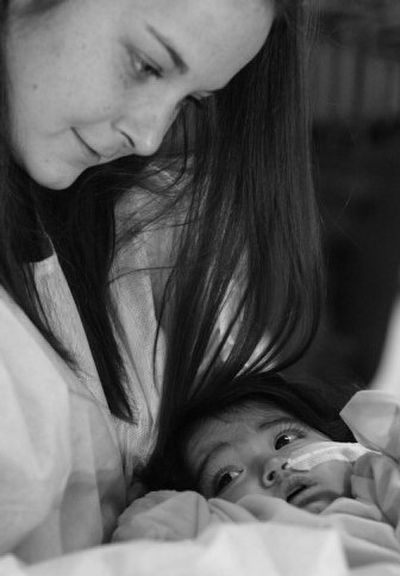Rare surgery has adult, baby split donated liver

WASHINGTON – The transplant surgeon had good news: A donated liver was on the way for critically ill Maggie Catherwood. Then he asked: Would she let doctors cut off part of her new liver to share with an equally sick baby?
“I can’t imagine anyone saying no,” the 21-year-old college student said last week as, teary-eyed, she met 8-month-old Allison Brown, carefully cuddling the wide-eyed baby so they wouldn’t bump each other’s healing incisions.
Actually, few ever get the choice – something the nation’s transplant network soon may change. There’s a push to increase liver-splitting that could have many more people who are awaiting transplants being asked to share a piece of their new organ.
If the proposed changes are enacted, “I think it’s safe to say we could nearly eliminate death on the pediatric liver waiting list,” said Allison’s surgeon, Dr. Thomas Fishbein of Georgetown University Hospital.
A liver is unlike any other organ: A piece of a healthy one can grow into a whole organ in about a month. That’s why some people receive liver transplants from living donors who have just a portion of their organ cut out and given away.
Split-liver donation is different. It divides an organ donated when someone dies to try to save two lives with one donation.
It doesn’t happen very often, accounting for between 2 percent and 3 percent of the more than 6,000 liver transplants annually. Just 123 split-liver transplants were performed in the U.S. last year, according to the United Network for Organ Sharing, which runs the transplant system.
Particularly rare, says Fishbein, is an adult agreeing to share a liver that the waiting-list rules deem completely his or hers. Usually when a liver is split, an organ too large for a baby or small child had to be cut to fit anyway – and pediatric surgeons who don’t want to waste the rest offer it to the next candidate on the waiting list.
“I didn’t even know it was possible” to split a liver, said Catherwood. But she said yes, and her first question upon waking up from surgery was, “How’s the baby?”
“The fact that someone else was willing to give up part of that liver they need is amazing to me,” said Terri Brown, Allison’s mother, in an emotional meeting with Catherwood 12 days after the transplants.
“Oh, she’s adorable, oh my gosh!” exclaimed Catherwood from her wheelchair as Allison’s father, Brian, handed her the baby, tiny white slippers peeking from beneath her blanket.
Not every transplant center has the expertise or incentive to split livers, especially those that treat only adults. It’s a more technically challenging operation. It poses a slightly higher risk of post-surgery complications, such as maintaining the good blood flow necessary for the organ to survive.
Nor is every donated liver splittable. It must be a very healthy organ, not the marginal ones often transplanted; typically, the donor was a young adult who died from an accident.
But a rough estimate from the United Network for Organ Sharing is that more than 1,000 livers donated a year might qualify for splitting. Fishbein is part of the network committee charged with spurring those transplants to try to save more youngsters. Between 10 percent and 13 percent of young children die while on the liver waiting list, including 41 babies last year.
Pending proposals would mandate that all transplant centers be notified when a potentially splitable liver is donated, and that the search for a matching recipient identify those willing to accept a partial organ.
Catherwood’s symptoms started in the fall, when suddenly she couldn’t keep food down. The day after her 21st birthday, she learned she had Wilson’s disease – her liver couldn’t properly dispose of the copper in food. The quiet buildup was destroying it. In early February, the Sterling, Va., woman joined the nearly 17,000 people on the waiting list for liver transplants.
Allison was 3 1/2 months old when doctors discovered her worsening jaundice meant biliary atresia – the Waldorf, Md., girl was born without all her major bile ducts. She joined the transplant list in early December, the whites of her eyes turning canary yellow as the months ticked by and her liver shut down.
Livers are distributed to the sickest patients first. Late on Feb. 27, Georgetown’s Dr. Cal Matsumoto got word that the transplant network had flagged Catherwood to receive a liver from a teenager who had just died. Knowing Allison was a match, too, he broached the two-for-one transplant.
The left lobe – just under 20 percent – went to Allison, the rest to Catherwood in an adjoining operating room.
For Catherwood and Allison, the transplant seems to be working, although they have the same risk of long-term organ rejection as any transplant recipient. Catherwood was recuperating at home, well enough even before she was discharged to indulge in chocolate. Allison remained in the hospital for observation, but her liver was clearing away the jaundice.
“It’s so exciting to see what her eyes look like,” her father said. “We got so lucky.”